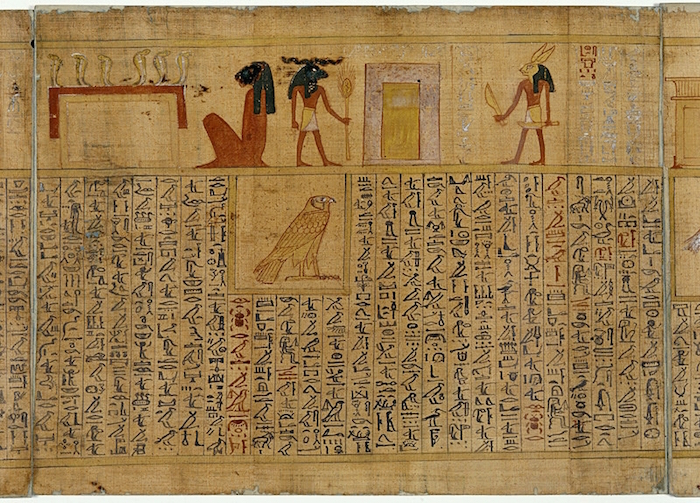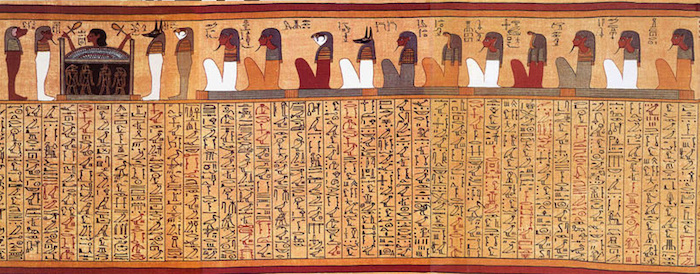The Book of the Dead (known to the Egyptians as “The Book of Coming Forth by Day”) is actually a huge collection of spells. There is no one copy which features all of the spells, but some (for example the Negative confession in Spell 125) were almost always included. Spells were generally written in hieroglyphs or hieratic (cursive hieroglyphs) on a papyrus roll which was placed in the tomb, but in some instances spells were inscribed or painted on the walls of a tomb or on an amulet. Many copies of the spells include beautiful vignettes depicting the deceased making their way through the Duat (underworld).

It is sometimes suggested that the Book of the Dead was a new form of religious text which developed towards the end of the second intermediate period (e.g. Assmann), but Grajetzki instead proposed an unbroken development of religious texts from the Old Kingdom (Pyramid Texts), through the Middle Kingdom (Coffin Texts) and into the New Kingdom and beyond (The Book of the Dead). Throughout these periods spells continued to be refined. Some remained in use for a long time, while others were only relevant for a shorter period or in a specific geographical area. He points out that our division of the texts into Coffin Text and the Book of the Dead is a modern one which relates more to the medium on which they were presented.
The difficulty we face in charting the development of texts through the Second Intermediate Period is in part because the texts were no longer placed on items (such as coffins) which were likely to survive.
Development of the Book of the Dead
The earliest versions of the Book of the Dead are from the Second Intermediate Period, in particular the coffins of Queen Montuhotep and the official Herunefer (once placed in the late Middle Kingdom but now placed in the sixteenth or seventeenth dynasties. These coffins included spells which were originally from the Pyramid Texts and Coffin Texts, but also a number of new spells (some of which were also claimed to have an earlier origin).
The coffin of Senenhenaef (Abydos Tomb D 25, late thirteenth or early seventeenth dynasty) features a spell which seems to be an intermediate stage between Coffin Text Spell 369 and Spell 33 of the Book of the Dead.

During the reign of Hatshepsut the collection of spells was, for the first time, given its own name, “The Book of Coming Forth by Day”, and spells from the Book of the Dead became common in the tombs of officials from the reign of Tuthmosis III. There was a brief interlude during the Amarna Period when the spells fell out of use, but they were soon back, appearing (among other places) on the gilded shrine of Tutankhamun.
From the reign of Merenptah, spells began appearing on the walls of tombs, starting with Spell 125 (the Judgement of the Dead). A selection of spells (particularly 148 and 110) appear on the walls of temples, and the spells associated with the heart (26, 30 and 30B) become common on amulets.
During the Ramesside Period (and more so during the Twenty-First Dynasty) we find copies of the Book of the Dead written in hieratic, although some continued to employ cursive hieroglyphs. These copies were often enclosed in a statue of Osiris and accompanied by a copy of the Amduat. Occasionally, a hybrid of the two texts was compiled. Some of the sections of the Book of the Dead were only represented visually, the text being entirely absent.
After the Twenty-second Dynasty, the Book of the Dead fell into disuse for a time, but it was revived and expanded during the Twenty-Sixth Dynasty. By the Thirtieth Dynasty some of the spells were painted on mummy wrappings, and during the Roman Period the text on these bandages was written in demotic.
Further Reading
Bibliography
- Faulkner, R.O (1972) The Ancient Egyptian Book of the Dead
- Grajetzki, W. (2006) “Another Early Source for the Book of the Dead: The Second Intermediate Period Burial D 25 at Abydos” Studien Zur Altägyptischen Kultur, 34 pp.205-216
- Hornung, Erik (1999) The Ancient Egyptian Books of the Afterlife
Copyright J Hill 2018